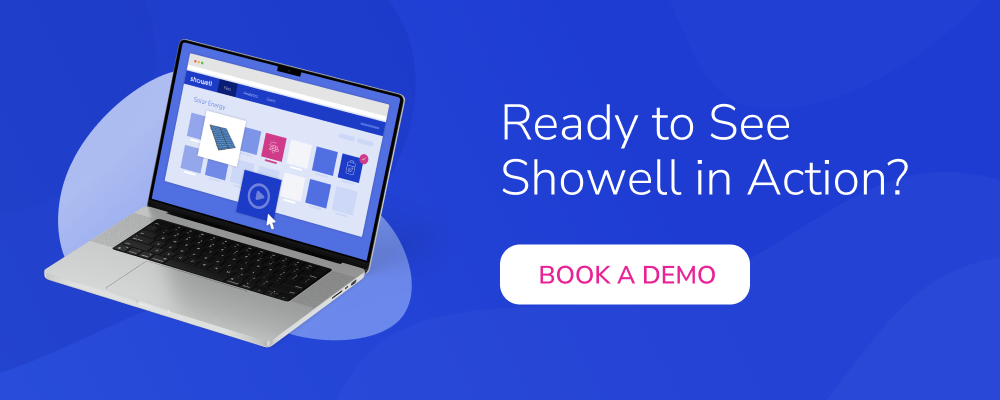Virtual sales meetings have lower attention levels compared to face-to-face interactions. Multitasking and distractions are common.
Buyer preferences are shifting, and multiple stakeholders add complexity. This blog provides B2B sales professionals with strategies to prepare engaging virtual sales meeting, foster buyer engagement, and sustain interest throughout the whole sales cycle.
By reading on, you'll gain insights that can help transform your virtual sales process from mundane to memorable, ensuring your message resonates powerfully with your prospects. Let's dive in!
Table of contents:
Why Engaging with Prospects is Harder in a Virtual Environment?
The landscape of B2B sales has been significantly altered by the rise of virtual sales meetings, transforming the way sales professionals engage with their prospects. While these digital shifts have presented us with new opportunities, they've also brought forth unique challenges, especially when it comes to maintaining buyer engagement. Why is buyer engagement such a challenging endeavor? Well, it's a multifaceted issue.
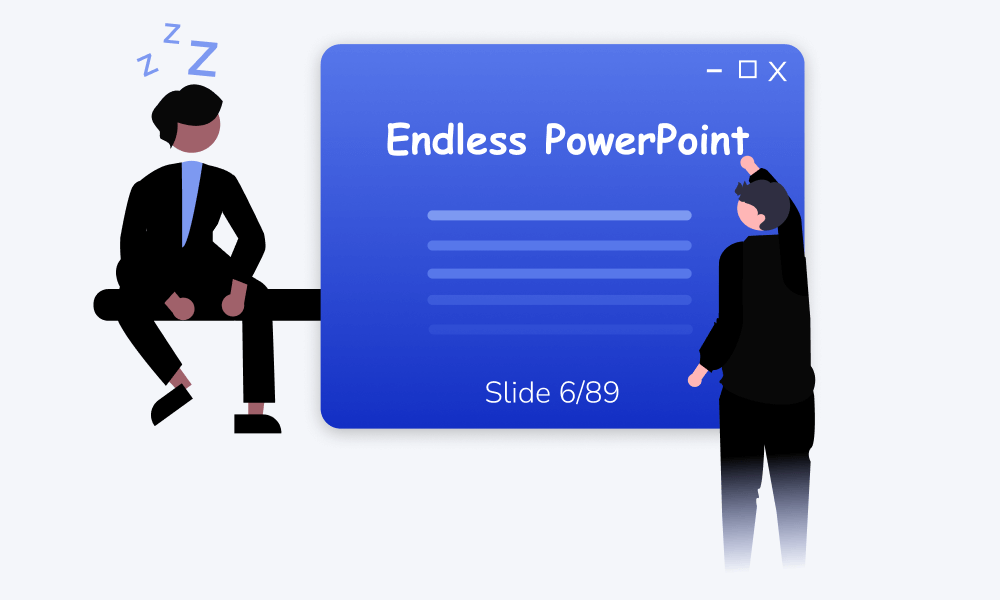
Virtual Environments Are Full of Distractions
Research from the University of Toronto, York University, and SUNY Albany revealed that while 94.4% of participants claimed they could pay attention during face-to-face meetings, the figure dropped to a mere 41.7% for virtual meetings.
Buyers often perceive virtual meetings as a license to multitask, leading to a rampant increase in distractions ranging from email notifications to the allure of social media. Add to this the Ringelmann effect, which states that the more people involved in a task, the less effort each individual devotes to it, and it becomes clear why engagement is such a tough nut to crack in virtual meetings.
Buyer Preferences Have Shifted
Recent data from Gartner uncovers even more challenges. A staggering 72% of organizations cite pipeline generation as a top priority, yet an effective engagement strategy often eludes them, leaving the door only half-open for potential prospects. Not helping the situation is the fact that 72% of buyers would prefer a rep-free experience, reflecting a shift in buyer preferences and making the task of buyer engagement more challenging than ever.
Number of Stakeholders is Increasing
Further compounding the problem is the increasing number of stakeholders involved in buying decisions, sometimes ranging from 11 to 20 individuals. With 70% of sales reps citing access to stakeholders as a top challenge, it's clear that we can no longer rely on single-threaded approaches within our accounts. Keeping multiple stakeholders engaged can be challenging.
Preparing for Your Virtual Sales Meeting
Being well-prepared for your meeting is a must. If you’re unprepared your meeting will most likely be a waste of time for you and your prospective customer. A great buying experience for your customer starts from this meeting - make it count. Follow these tips to set yourself up for success in your next virtual sales meeting.
Understanding Your Prospect
A successful B2B sales strategy begins with understanding your prospect. A buyer-centric approach puts the buyer at the center of everything you do as a sales professional. This approach transforms the activities, metrics, content, communication, and even the organizational structure of your sales and marketing teams.
At its core, it's a simple, yet powerful strategy that can significantly boost your company's ability to achieve its revenue objectives.
Understanding your prospect goes beyond just recognizing their company name or the industry they belong to. It involves a deep dive into their profile, their needs, their challenges, and their aspirations. The depth of your understanding of your potential customer can drastically influence their buying decisions.
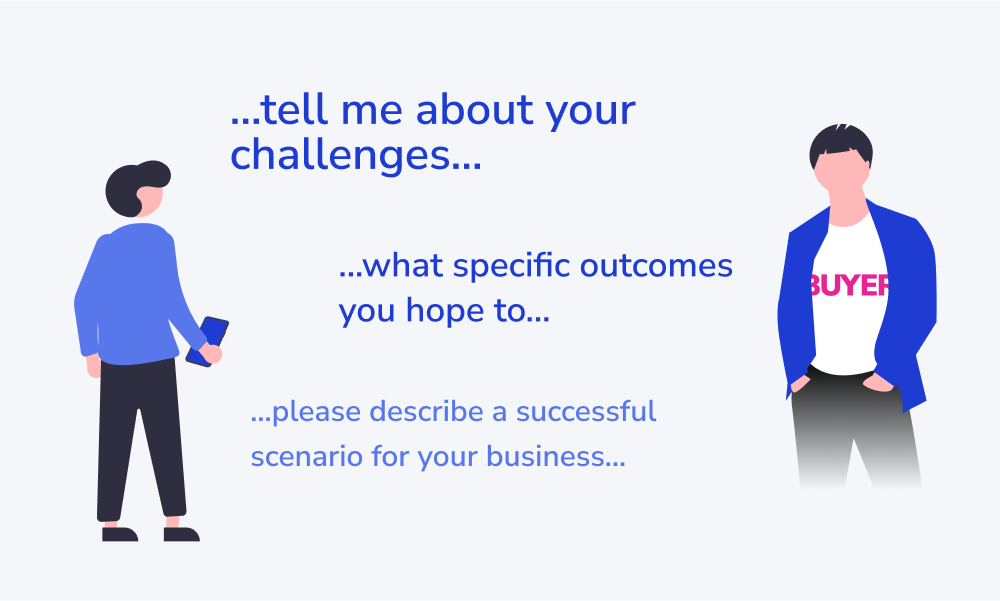
Buyers' decisions are significantly influenced by the behavior of the salesperson. To make an impact as a salesperson you need to understand the buyers’ concerns, wants and needs, you need to be able to solve their problems, show an ability to listen, and clearly articulate the ROI your solution will deliver.
Developing a deep understanding of your prospect is not a step in the sales process, but rather the basis on which the entire process is built. By putting your prospect at the center of everything you do, you can tailor your approach, message, and solution to fit their unique needs, thereby increasing your chances of closing the deal.
Proper sales call preparation is key to mastering this process. Understanding your prospect, structuring your pitch, and anticipating objections will ensure you're fully equipped to handle the conversation with confidence.
In the next section, we’ll guide you through the process of tailoring your pitch and preparing yourself and your surroundings for the meeting.
Preparing Your Sales Pitch and Materials
Once you understand your prospect, design your pitch to address their pain points and highlight your value proposition. A well-crafted sales presentation is more than just an attractive slideshow—it's a strategic tool for communication, designed to tell a compelling story that captivates your audience. To maximize the impact of your sales pitch, there are a few key principles to keep in mind:
- Tailor your presentation: One-size-fits-all rarely works in sales. If your deck is filled with generic slides about you, your product, and your company, you risk losing the interest of your prospect. Instead, make your presentation about them—about their needs, their problems, and how your solution can help. Every sales prospect is different, with their own unique set of challenges, goals, and pain points. Your sales pitch should address these individual nuances directly.
Read more about Learn 8 Rules of Tailoring Your Presentations →
- Simplicity is key: A cluttered, overly complex presentation may confuse your audience and detract from your main message. Keep your slides simple and clean, focusing on the key points you want to convey. Use visuals to enhance understanding, not to overwhelm.
- Tell stories: Consider incorporating storytelling into your sales pitch. There are several reasons why storytelling can be so effective in sales. They appeal to emotions, they help you demonstrate value in a more relatable way, and they’re also memorable and more likely to stick. Most importantly stories humanize the salesperson, building rapport and establishing credibility. This trust fosters a positive relationship and makes the listener more receptive to the salesperson's message.
- Create a conversation: Engage your audience by asking questions and encouraging participation. This turns your pitch into a conversation and allows for a deeper connection with your prospect. Your presentation should be a guide, not a script, helping you navigate the discussion and steer it toward a productive conclusion.
- Be ready to pivot: No matter how well you prepare, expect the unexpected. Sales meetings often go off-script, with prospects asking unforeseen questions or bringing up new topics. Be prepared to adapt on the fly. This requires being able to access all of your sales and marketing materials easily. The ability to pull up the necessary information at the moment can be a significant advantage, eliminating the need for unnecessary follow-up emails and keeping the sales process streamlined and efficient.
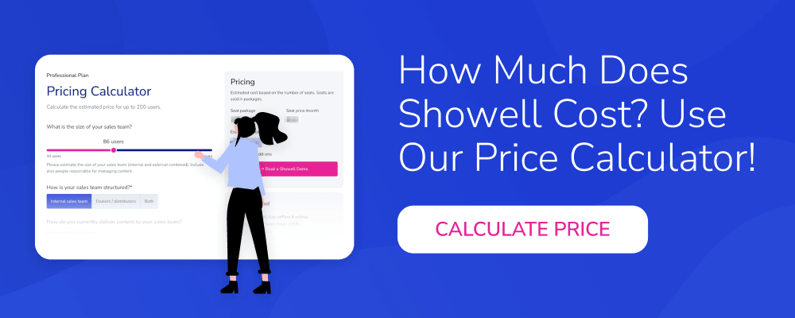 In essence, your sales presentation is an opportunity to demonstrate to your prospect that you understand their needs, that you have a solution to their problems, and that the benefits of your product or service outweigh the costs. When well-executed, your sales pitch can be a powerful tool in converting prospects into customers.
In essence, your sales presentation is an opportunity to demonstrate to your prospect that you understand their needs, that you have a solution to their problems, and that the benefits of your product or service outweigh the costs. When well-executed, your sales pitch can be a powerful tool in converting prospects into customers.Controlling Your Environment
In a virtual sales meeting, your environment plays a key role. An uncluttered, professional background can enhance your credibility while minimizing distractions. Make sure your technology—audio, video, and internet connection—is reliable and tested beforehand to avoid any glitches during the meeting. Finally, make sure you’re dressed appropriately and remember to smile and keep eye contact.
How to Keep Prospects Engaged Throughout the Meeting
Now that you’ve done all the work in preparing for the meeting, the next step is to ensure that your prospective customer remains engaged throughout the meeting. You’ve done your research, you’ve prepared the materials, your setup, and yourself for the call - now it’s time to execute. Let’s look at different ways of managing engagement.
Set Yourself Up For Success with Strategic scheduling
One key strategy to keep buyers engaged during virtual sales meetings is to consider the timing of your meetings. For example, holding meetings in the 15s and 45s can provide your clients with much-needed mental breaks from other meetings that are typically held in the 00s and 30s. This unconventional timing can provide a refreshing change and reduce the fatigue that comes with back-to-back meetings.
In addition, scheduling meetings earlier in the day can help you to avoid being just another meeting in a long line of virtual encounters. This way, you'll be less likely to face an audience already drained from an overload of screen time and more likely to engage with buyers when they are fresh and receptive.
Control The Size of Your Audience
It can be beneficial to limit the number of attendees in your virtual meeting. This is to mitigate the Ringelmann effect, which posits that the more people involved in a task, the less effort each individual puts into it. While it's important to have the right decision-makers and influencers present, a larger meeting can make it harder to maintain engagement.

By keeping the group size manageable, you can keep the engagement threshold low and the conversation more personalized and interactive. This ensures that your virtual meeting can be as engaging as a face-to-face meeting would have been.
Make a Strong First Impression
In a virtual setting, it's essential to captivate your audience right from the start. An engaging and impactful introduction can set the stage for a productive meeting. This could be, for example, a powerful question or a surprising fact. Anything that creates an impact and makes your meeting stand out from the countless others will serve to engage your audience from the onset. Make it clear that you understand their needs and are ready to offer valuable solutions.
Read more about 16 Effective Sales Meeting Icebreakers and Techniques →
Make The Buyer The Topic of Discussion
Centering your discussion around the buyer is crucial in virtual sales meetings. People are naturally more interested when they're the focus of the conversation. This can involve discussing their specific pain points, their goals, and how your product or service can provide solutions. This personalized approach not only holds their interest but also demonstrates that you understand their needs and are capable of meeting them.
Use Storytelling
Earlier in the preparation stage, we mentioned that you could incorporate storytelling into your sales pitch. Telling frequent, brief stories can make your meetings more engaging and memorable. Whether it's a success story of a previous client or a narrative that explains the rationale behind your product or service, stories can humanize your brand and make your message more relatable.
Read more about 5 Proven Storytelling Techniques in Sales to Improve Your Pitch →

Don’t Talk Too Much
Lastly, it's advisable to keep any talking to three minutes at most. If you find you have more to say, make sure you don't speak for longer than five minutes before asking a question or checking in with your audience. This keeps the meeting interactive and ensures that the attention of your audience doesn't wane. Remember to keep the meeting conversational, focus on the prospect, ask the right closing questions, and interact. Aim for dialogue with the buyer.
How to Continue Buyer Engagement Post-Call
Keeping your prospect engaged during the initial meeting is only the beginning. You need to keep the conversation going throughout the process. Let’s dig into some tactics to keep your prospective client engaged.
Follow-up Messaging
Follow-up messaging is a critical step in the sales process, especially after a virtual sales meeting. It not only shows your diligence and interest in serving the client but also helps keep the conversation going, reinforcing the key points discussed during the meeting and opening the door to further engagement. Let's delve into some tactics to make your follow-up messages more impactful and effective.
1) Timing is key. Sending a follow-up message immediately after the meeting demonstrates promptness and shows your dedication to the client's needs. However, it’s also essential to balance this urgency with thoughtfulness. Your message should be more than just a “thank you for your time” note; it should summarize key points from the meeting, reaffirm commitments made, and propose the next steps. This email should be sent within 24 hours of the meeting, while the discussion is still fresh in the prospect's mind.
2) Personalize your messages. Personalization goes beyond just addressing the client by their name. Tailor your message to reflect the unique discussions and understandings you shared during the meeting. This shows the client that you listened and that you are invested in their specific situation and needs.
3) Provide additional value. This could be in the form of a relevant article, a case study, or an invitation to a webinar that relates to the client's interests or challenges. Providing additional resources shows the client that you are actively thinking about their needs and are committed to offering solutions.
4) Clarity on the next steps is crucial. Whether it's scheduling a follow-up call, expecting a response, or delivering a proposal, always end your follow-up message with a clear indication of what comes next. This shows the client that you have a plan and are driving the relationship forward.
For instance, your follow-up message might read:
| Dear [Client's Name], Thank you for your time today. I enjoyed our conversation about [specific topic]. I understand that [restate a key point or challenge the client mentioned] is a major priority for you. In light of this, [mention the specific solution or idea you proposed]. As agreed, I will [mention the next steps]. I would also like to share a customer success story that is related to our discussion. [Reference Key: insert link or attachment here] This success story showcases how our solutions have been effectively implemented to address similar challenges. I believe this could offer valuable insights for your own objectives. I look forward to our continued collaboration. [Signature] |
In essence, effective follow-up messaging after a virtual sales meeting should be timely, personalized, value-adding, and forward-looking. With these elements, you can make sure that your follow-up communication promotes engagement from the buyer.
Content Sharing and Digital Sales Rooms
Keep the conversation going by sharing relevant content with your buyer that expands on your solution's benefits. A best practice is setting up a digital sales room—a dedicated space where prospects can find further information about your products, services, and company. This can keep them engaged and interested while moving them further along the sales pipeline.
The Digital Sales Room is not just a repository; it's a dynamic platform where you can share your tailored pitch from your meeting with the prospect, and provide additional personalized content that addresses the pain points, challenges, goals, and objectives that you’ve uncovered in previous interactions.
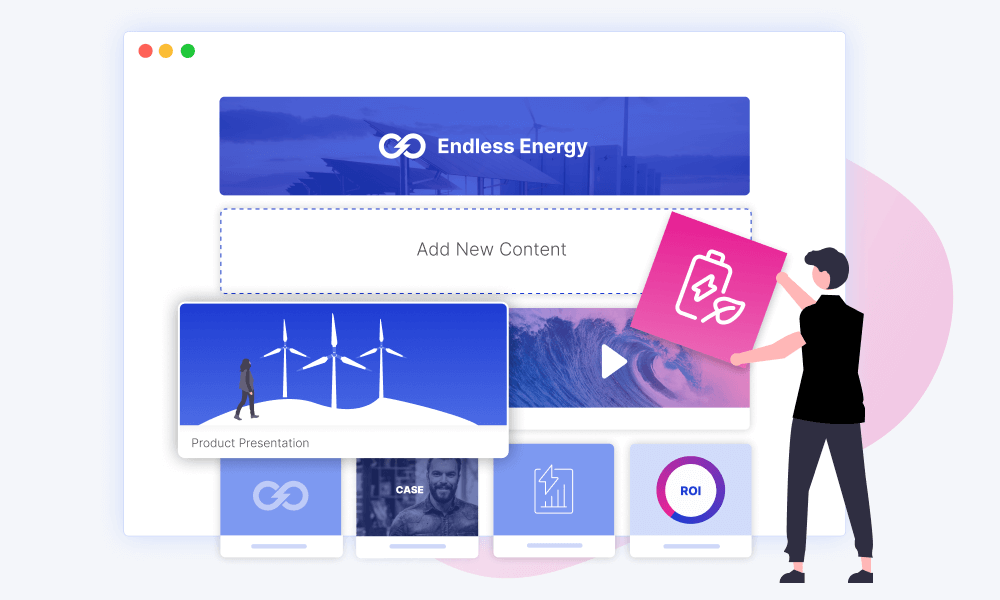
Learn more about Digital Sales Room: Digital Sales Room: Everything You Need To Know →
Digital sales rooms make it easy for the buyer to navigate through the relevant material that’s been shared with them. Moreover, the platform allows for tracking of content usage, providing valuable insights into what the buyer is engaging with and how they're interacting with the materials.
There are three key reasons why Digital Sales Rooms are critical for modern sales processes:
1) Centralization of Content: By gathering all relevant sales and marketing content in one place, the process is significantly streamlined. This not only makes the buyer's life easier but also leaves a lasting positive impression on them.
2) Showcasing Capabilities: Salesmanship requires a degree of showmanship. Modern presentation tools combined with a savvy platform allow sales representatives to effectively showcase their products or services, helping to close deals faster.
3) Tracking Reactions: It's essential to understand your customers, and tracking shared content can provide valuable insights. Knowing who shared what, who said what, and at what stage of the sales cycle interactions occurred can give a clear picture of the buyer's journey.
In essence, the Digital Sales Room is a shared space that promotes engagement. It facilitates collaboration and critical decision-making, keeping all parties informed throughout the entire sales process. It also provides an inspiring and engaging buyer experience, replacing endless email chains and scattered content with a centralized tool for presentation, storage, and sharing. Create your own Digital Sales Room with Showell Free.
Conclusion
Engaging prospects in a virtual sales meeting is not just about the meeting itself. It's a holistic process that begins with thorough preparation and continues throughout the buying process. By understanding your prospects, delivering value, fostering interactivity, and maintaining consistent follow-up, you can create a memorable experience that keeps prospects engaged and more likely to convert.
Remember that at the core of every successful virtual sales meeting is a genuine human connection. Despite the digital nature of these interactions, authenticity and empathy can shine through, helping you build strong relationships and win trust, which is ultimately what drives success in B2B sales.
Navigating the world of virtual sales meetings can be challenging, but with the right strategies in place, you're well-equipped to engage your prospects and move them closer to a positive buying decision. So, embrace these tips, and here's to many successful virtual sales meetings ahead!
Learn next:
-
10 High-Impact Types of Sales Collateral That Drive Results + Examples
-
Updated 2024: List Of Top Sales Presentation Templates You Need
Showell can help you drive engagement throughout the sales cycle. You can use it to create a bespoke presentation by combining slides, brochures, and videos into a tailored deck. It allows you to present your content and to react on the call to any unexpected queries.
And finally, it gives you the opportunity to create a shared space where you can distribute relevant material throughout the cycle to all stakeholders involved in the buying process. Curious to learn more? Book a meeting with a Sales Enablement Expert by clicking the banner below or Get Showell Free




